Chuteng Zhou
wav2pos: Sound Source Localization using Masked Autoencoders
Aug 28, 2024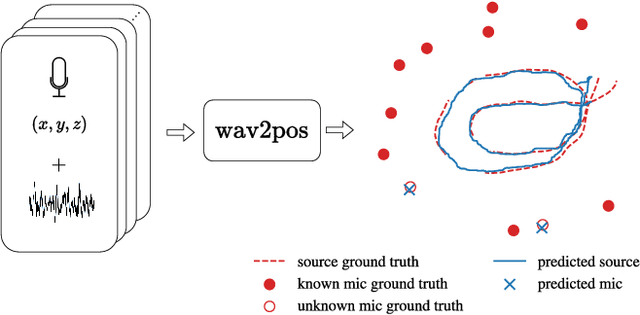



Abstract:We present a novel approach to the 3D sound source localization task for distributed ad-hoc microphone arrays by formulating it as a set-to-set regression problem. By training a multi-modal masked autoencoder model that operates on audio recordings and microphone coordinates, we show that such a formulation allows for accurate localization of the sound source, by reconstructing coordinates masked in the input. Our approach is flexible in the sense that a single model can be used with an arbitrary number of microphones, even when a subset of audio recordings and microphone coordinates are missing. We test our method on simulated and real-world recordings of music and speech in indoor environments, and demonstrate competitive performance compared to both classical and other learning based localization methods.
Towards Federated Learning with On-device Training and Communication in 8-bit Floating Point
Jul 02, 2024Abstract:Recent work has shown that 8-bit floating point (FP8) can be used for efficiently training neural networks with reduced computational overhead compared to training in FP32/FP16. In this work, we investigate the use of FP8 training in a federated learning context. This brings not only the usual benefits of FP8 which are desirable for on-device training at the edge, but also reduces client-server communication costs due to significant weight compression. We present a novel method for combining FP8 client training while maintaining a global FP32 server model and provide convergence analysis. Experiments with various machine learning models and datasets show that our method consistently yields communication reductions of at least 2.9x across a variety of tasks and models compared to an FP32 baseline.
PerfSAGE: Generalized Inference Performance Predictor for Arbitrary Deep Learning Models on Edge Devices
Jan 26, 2023Abstract:The ability to accurately predict deep neural network (DNN) inference performance metrics, such as latency, power, and memory footprint, for an arbitrary DNN on a target hardware platform is essential to the design of DNN based models. This ability is critical for the (manual or automatic) design, optimization, and deployment of practical DNNs for a specific hardware deployment platform. Unfortunately, these metrics are slow to evaluate using simulators (where available) and typically require measurement on the target hardware. This work describes PerfSAGE, a novel graph neural network (GNN) that predicts inference latency, energy, and memory footprint on an arbitrary DNN TFlite graph (TFL, 2017). In contrast, previously published performance predictors can only predict latency and are restricted to pre-defined construction rules or search spaces. This paper also describes the EdgeDLPerf dataset of 134,912 DNNs randomly sampled from four task search spaces and annotated with inference performance metrics from three edge hardware platforms. Using this dataset, we train PerfSAGE and provide experimental results that demonstrate state-of-the-art prediction accuracy with a Mean Absolute Percentage Error of <5% across all targets and model search spaces. These results: (1) Outperform previous state-of-art GNN-based predictors (Dudziak et al., 2020), (2) Accurately predict performance on accelerators (a shortfall of non-GNN-based predictors (Zhang et al., 2021)), and (3) Demonstrate predictions on arbitrary input graphs without modifications to the feature extractor.
UDC: Unified DNAS for Compressible TinyML Models
Jan 21, 2022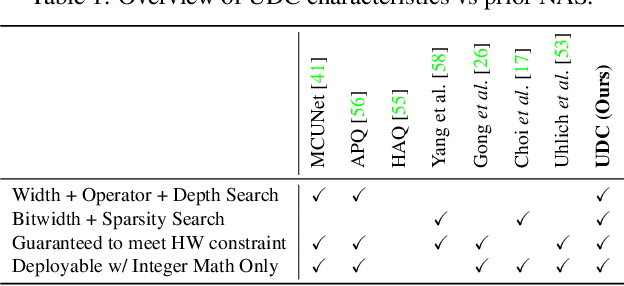
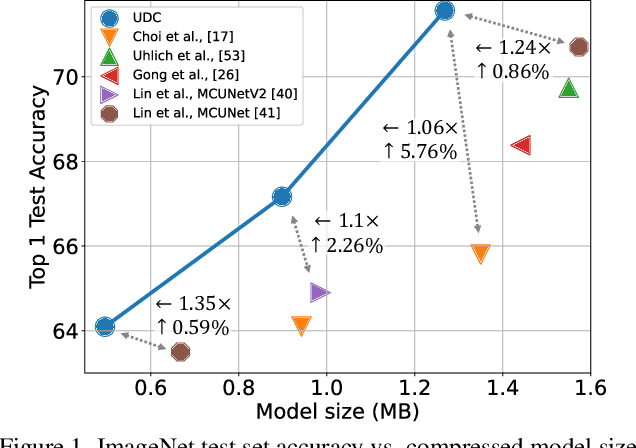
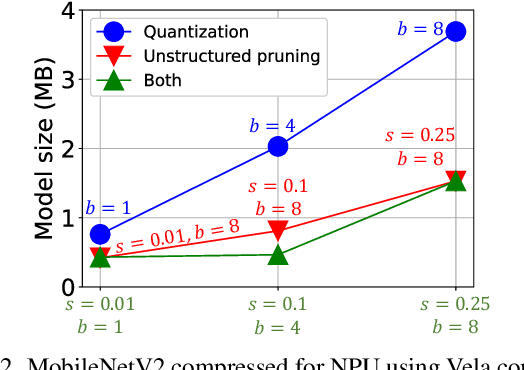

Abstract:Emerging Internet-of-things (IoT) applications are driving deployment of neural networks (NNs) on heavily constrained low-cost hardware (HW) platforms, where accuracy is typically limited by memory capacity. To address this TinyML challenge, new HW platforms like neural processing units (NPUs) have support for model compression, which exploits aggressive network quantization and unstructured pruning optimizations. The combination of NPUs with HW compression and compressible models allows more expressive models in the same memory footprint. However, adding optimizations for compressibility on top of conventional NN architecture choices expands the design space across which we must make balanced trade-offs. This work bridges the gap between NPU HW capability and NN model design, by proposing a neural architecture search (NAS) algorithm to efficiently search a large design space, including: network depth, operator type, layer width, bitwidth, sparsity, and more. Building on differentiable NAS (DNAS) with several key improvements, we demonstrate Unified DNAS for Compressible models (UDC) on CIFAR100, ImageNet, and DIV2K super resolution tasks. On ImageNet, we find Pareto dominant compressible models, which are 1.9x smaller or 5.76% more accurate.
AnalogNets: ML-HW Co-Design of Noise-robust TinyML Models and Always-On Analog Compute-in-Memory Accelerator
Nov 10, 2021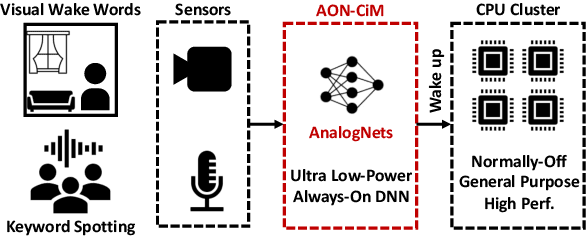
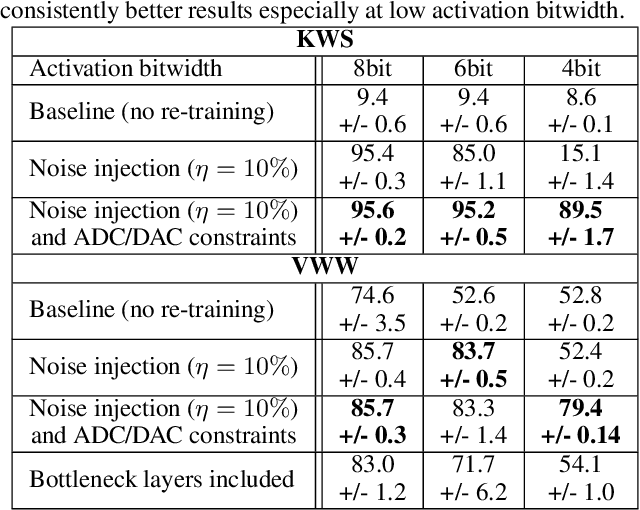
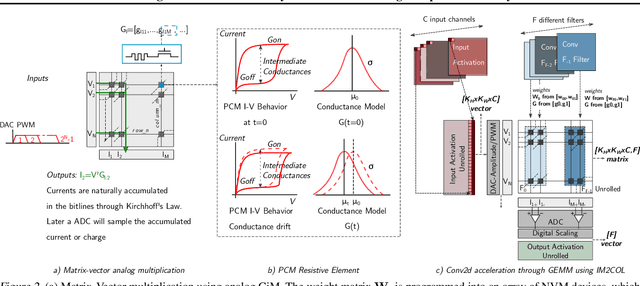
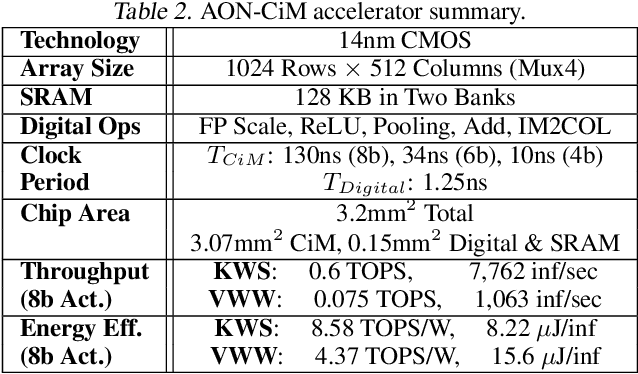
Abstract:Always-on TinyML perception tasks in IoT applications require very high energy efficiency. Analog compute-in-memory (CiM) using non-volatile memory (NVM) promises high efficiency and also provides self-contained on-chip model storage. However, analog CiM introduces new practical considerations, including conductance drift, read/write noise, fixed analog-to-digital (ADC) converter gain, etc. These additional constraints must be addressed to achieve models that can be deployed on analog CiM with acceptable accuracy loss. This work describes $\textit{AnalogNets}$: TinyML models for the popular always-on applications of keyword spotting (KWS) and visual wake words (VWW). The model architectures are specifically designed for analog CiM, and we detail a comprehensive training methodology, to retain accuracy in the face of analog non-idealities, and low-precision data converters at inference time. We also describe AON-CiM, a programmable, minimal-area phase-change memory (PCM) analog CiM accelerator, with a novel layer-serial approach to remove the cost of complex interconnects associated with a fully-pipelined design. We evaluate the AnalogNets on a calibrated simulator, as well as real hardware, and find that accuracy degradation is limited to 0.8$\%$/1.2$\%$ after 24 hours of PCM drift (8-bit) for KWS/VWW. AnalogNets running on the 14nm AON-CiM accelerator demonstrate 8.58/4.37 TOPS/W for KWS/VWW workloads using 8-bit activations, respectively, and increasing to 57.39/25.69 TOPS/W with $4$-bit activations.
Active multi-fidelity Bayesian online changepoint detection
Mar 26, 2021
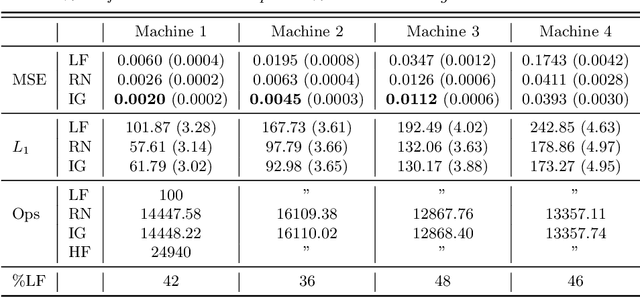


Abstract:Online algorithms for detecting changepoints, or abrupt shifts in the behavior of a time series, are often deployed with limited resources, e.g., to edge computing settings such as mobile phones or industrial sensors. In these scenarios it may be beneficial to trade the cost of collecting an environmental measurement against the quality or "fidelity" of this measurement and how the measurement affects changepoint estimation. For instance, one might decide between inertial measurements or GPS to determine changepoints for motion. A Bayesian approach to changepoint detection is particularly appealing because we can represent our posterior uncertainty about changepoints and make active, cost-sensitive decisions about data fidelity to reduce this posterior uncertainty. Moreover, the total cost could be dramatically lowered through active fidelity switching, while remaining robust to changes in data distribution. We propose a multi-fidelity approach that makes cost-sensitive decisions about which data fidelity to collect based on maximizing information gain with respect to changepoints. We evaluate this framework on synthetic, video, and audio data and show that this information-based approach results in accurate predictions while reducing total cost.
Information contraction in noisy binary neural networks and its implications
Feb 01, 2021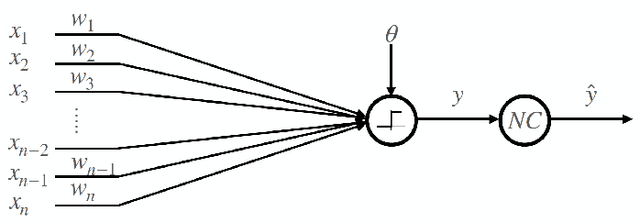
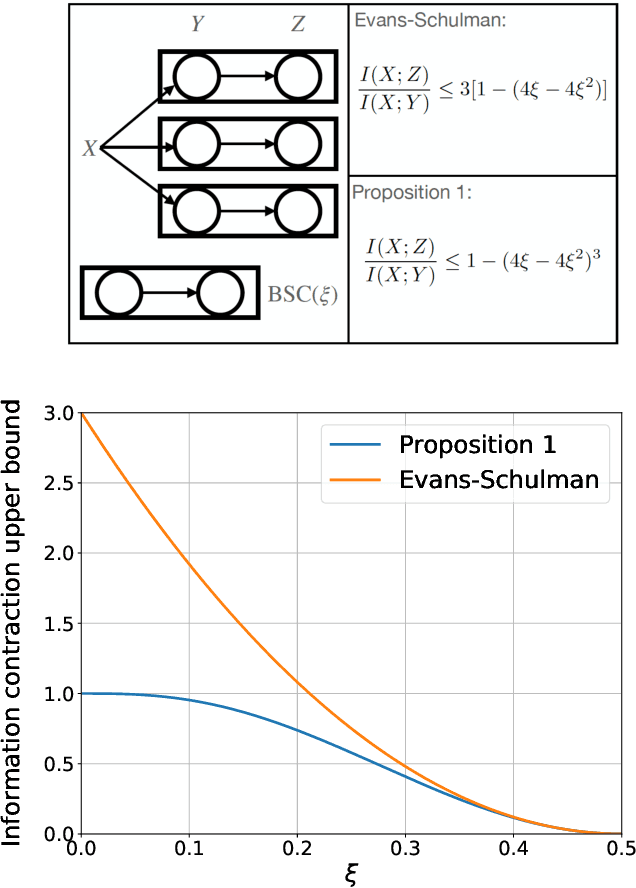
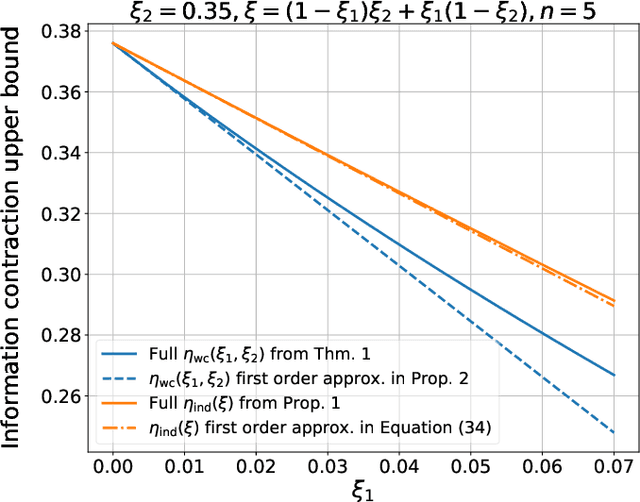
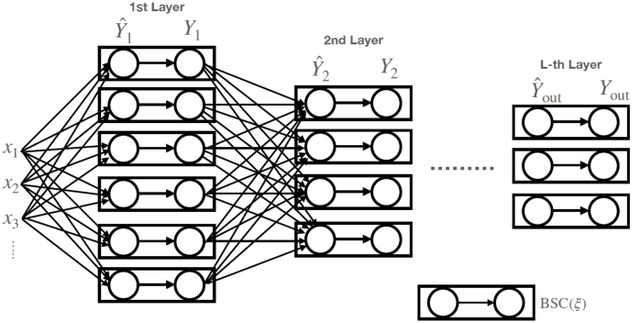
Abstract:Neural networks have gained importance as the machine learning models that achieve state-of-the-art performance on large-scale image classification, object detection and natural language processing tasks. In this paper, we consider noisy binary neural networks, where each neuron has a non-zero probability of producing an incorrect output. These noisy models may arise from biological, physical and electronic contexts and constitute an important class of models that are relevant to the physical world. Intuitively, the number of neurons in such systems has to grow to compensate for the noise while maintaining the same level of expressive power and computation reliability. Our key finding is a lower bound for the required number of neurons in noisy neural networks, which is first of its kind. To prove this lower bound, we take an information theoretic approach and obtain a novel strong data processing inequality (SDPI), which not only generalizes the Evans-Schulman results for binary symmetric channels to general channels, but also improves the tightness drastically when applied to estimate end-to-end information contraction in networks. Our SDPI can be applied to various information processing systems, including neural networks and cellular automata. Applying the SDPI in noisy binary neural networks, we obtain our key lower bound and investigate its implications on network depth-width trade-offs, our results suggest a depth-width trade-off for noisy neural networks that is very different from the established understanding regarding noiseless neural networks. Furthermore, we apply the SDPI to study fault-tolerant cellular automata and obtain bounds on the error correction overheads and the relaxation time. This paper offers new understanding of noisy information processing systems through the lens of information theory.
MicroNets: Neural Network Architectures for Deploying TinyML Applications on Commodity Microcontrollers
Oct 25, 2020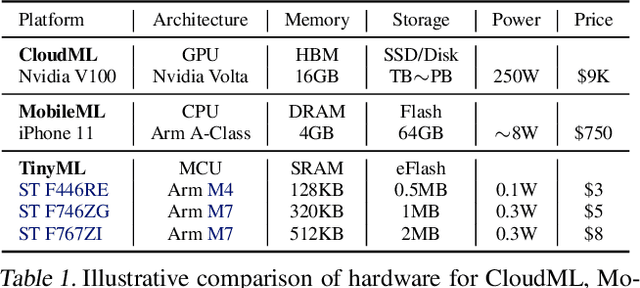
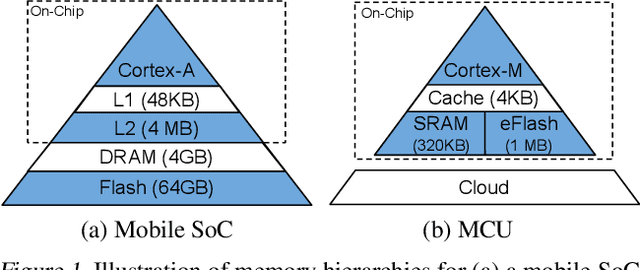
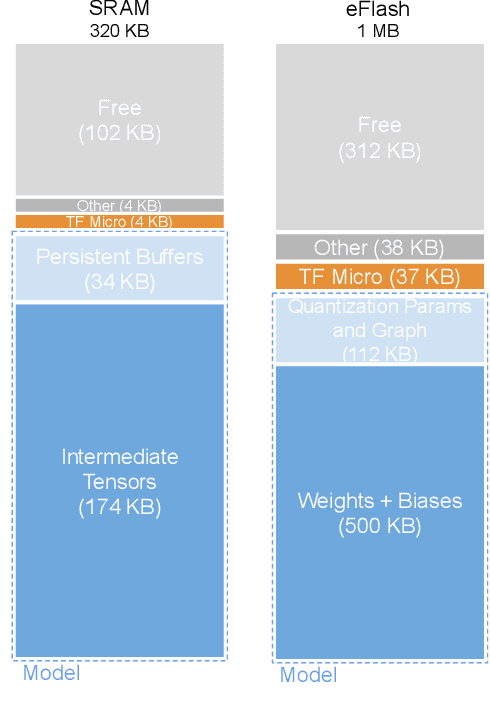
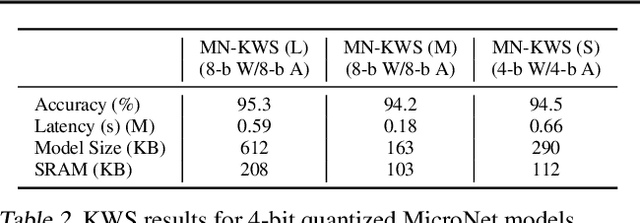
Abstract:Executing machine learning workloads locally on resource constrained microcontrollers (MCUs) promises to drastically expand the application space of IoT. However, so-called TinyML presents severe technical challenges, as deep neural network inference demands a large compute and memory budget. To address this challenge, neural architecture search (NAS) promises to help design accurate ML models that meet the tight MCU memory, latency and energy constraints. A key component of NAS algorithms is their latency/energy model, i.e., the mapping from a given neural network architecture to its inference latency/energy on an MCU. In this paper, we observe an intriguing property of NAS search spaces for MCU model design: on average, model latency varies linearly with model operation (op) count under a uniform prior over models in the search space. Exploiting this insight, we employ differentiable NAS (DNAS) to search for models with low memory usage and low op count, where op count is treated as a viable proxy to latency. Experimental results validate our methodology, yielding our MicroNet models, which we deploy on MCUs using Tensorflow Lite Micro, a standard open-source NN inference runtime widely used in the TinyML community. MicroNets demonstrate state-of-the-art results for all three TinyMLperf industry-standard benchmark tasks: visual wake words, audio keyword spotting, and anomaly detection.
Noisy Machines: Understanding Noisy Neural Networks and Enhancing Robustness to Analog Hardware Errors Using Distillation
Jan 14, 2020
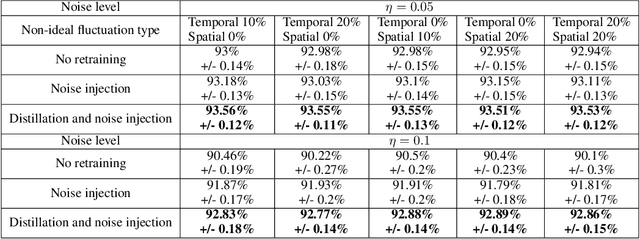
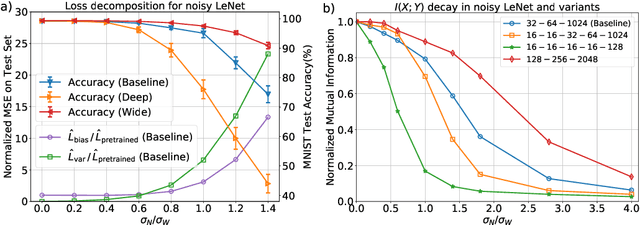

Abstract:The success of deep learning has brought forth a wave of interest in computer hardware design to better meet the high demands of neural network inference. In particular, analog computing hardware has been heavily motivated specifically for accelerating neural networks, based on either electronic, optical or photonic devices, which may well achieve lower power consumption than conventional digital electronics. However, these proposed analog accelerators suffer from the intrinsic noise generated by their physical components, which makes it challenging to achieve high accuracy on deep neural networks. Hence, for successful deployment on analog accelerators, it is essential to be able to train deep neural networks to be robust to random continuous noise in the network weights, which is a somewhat new challenge in machine learning. In this paper, we advance the understanding of noisy neural networks. We outline how a noisy neural network has reduced learning capacity as a result of loss of mutual information between its input and output. To combat this, we propose using knowledge distillation combined with noise injection during training to achieve more noise robust networks, which is demonstrated experimentally across different networks and datasets, including ImageNet. Our method achieves models with as much as two times greater noise tolerance compared with the previous best attempts, which is a significant step towards making analog hardware practical for deep learning.
FixyNN: Efficient Hardware for Mobile Computer Vision via Transfer Learning
Feb 27, 2019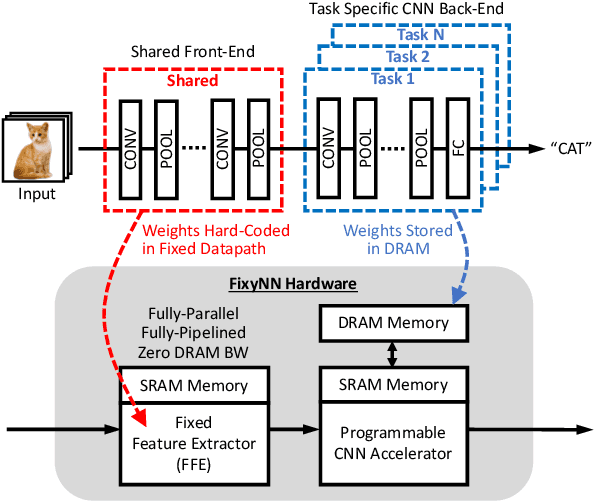



Abstract:The computational demands of computer vision tasks based on state-of-the-art Convolutional Neural Network (CNN) image classification far exceed the energy budgets of mobile devices. This paper proposes FixyNN, which consists of a fixed-weight feature extractor that generates ubiquitous CNN features, and a conventional programmable CNN accelerator which processes a dataset-specific CNN. Image classification models for FixyNN are trained end-to-end via transfer learning, with the common feature extractor representing the transfered part, and the programmable part being learnt on the target dataset. Experimental results demonstrate FixyNN hardware can achieve very high energy efficiencies up to 26.6 TOPS/W ($4.81 \times$ better than iso-area programmable accelerator). Over a suite of six datasets we trained models via transfer learning with an accuracy loss of $<1\%$ resulting in up to 11.2 TOPS/W - nearly $2 \times$ more efficient than a conventional programmable CNN accelerator of the same area.
 Add to Chrome
Add to Chrome Add to Firefox
Add to Firefox Add to Edge
Add to Edge